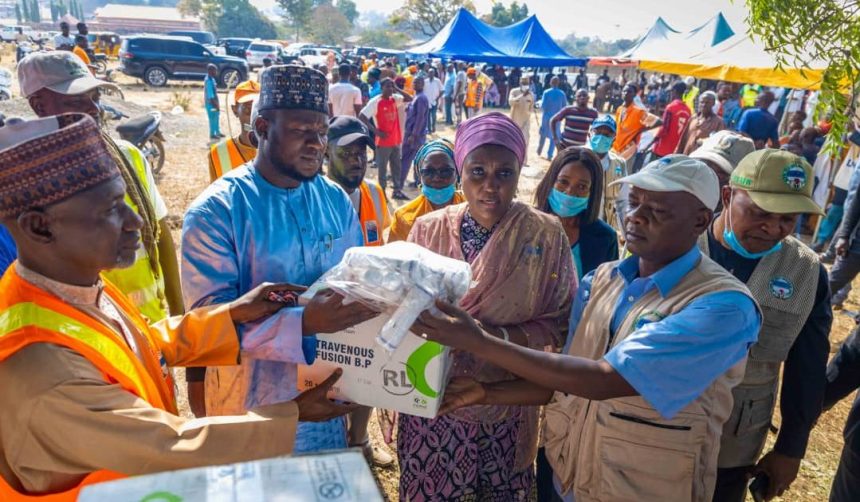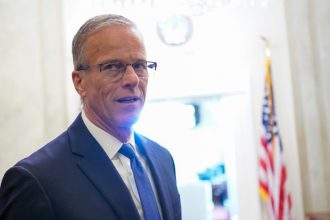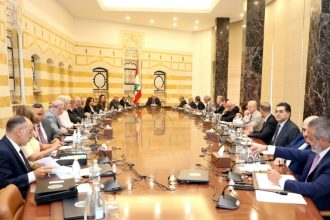The National Emergency Management Agency on Thursday conducted a full-scale flood response simulation exercise in Kebbi State to strengthen preparedness and response mechanisms to flooding emergencies
The simulation exercise, conducted in collaboration with the Kebbi State Government, took place along the riverbanks in Dukku town, a suburb of Birnin Kebbi in Kebbi State.
The exercise serves as a practical test of emergency plans, communication systems, and collaboration among disaster response agencies.
The exercise marked the conclusion of a five-day capacity-building on flood response for stakeholders, including local divers, canoe operators, members of the armed forces, the Federal Road Safety Corps, Nigeria Security and Civil Defence Corps, the National Inland Waterways Authority, and the Nigerian Red Cross Society, among others.
Speaking at the programme, the Director General of NEMA, Mrs Zubaida Umar, said the exercise is a critical component of the collective preparedness efforts aimed at enhancing coordination, communication, and efficiency amongst all stakeholders in disaster management in Nigeria.
She urged participants to approach the simulation exercise with professionalism and a commitment to learning, in order to identify gaps and enhance future response capabilities.
She noted that Sokoto, Kebbi, Zamfara, Niger, and Kwara states have been identified by the Nigerian Meteorological Agency, and the Nigeria Hydrological Services Agency as flood-prone areas in the 2025 seasonal climate prediction and annual flood outlook.
She said, “As we all know, flood remains one of the most recurrent and devastating natural disasters in Nigeria, with far-reaching impacts on lives, livelihoods, infrastructure, and communities.
“The recent flood disaster witnessed at Mokwa in Niger state attests to this fact. The essence of this simulation is not only to test our plans and protocols, but also to expose any gaps and strengthen our multi-agency collaboration.
“Today, we are simulating a crisis so that we are better prepared to save lives when it becomes a reality.
“Let me reiterate that preparedness saves lives. Our ability to respond, anticipate, and recover quickly from disasters depends largely on how well we train and work together before disaster strikes. This simulation exercise is therefore a proactive step in the right direction.
“As we go through this exercise, I urge all participants to approach it with professionalism and a learning mindset.
“This will enable us to identify areas for improvement and also ensure that lessons learnt better equip us for future plans and responses.”
Umar also noted that many state governments are now demonstrating a higher level of proactivity in disaster preparedness and emergency response efforts.
She highlighted that the growing involvement reflects a positive shift toward stronger collaboration and leadership among stakeholders at the state level.
As part of its outreach, NEMA also donated life jackets to the local community to enhance safety during water-related emergencies.
The Governor of Kebbi State, Nasir Idris, said the government is committed to the safety and welfare of citizens.
Nasir, who was represented by the Commissioner for Humanitarian Affairs, Muhammad Hamidu-Jarkuka, praised the governor for his visionary and proactive leadership in disaster preparedness.
“His visionary leadership and service to the people of our state, his visionary leadership and proactive approach to disaster preparedness have continued to set heavy steps on a path of resilience, safety, and sustainable development.
“Under his able leadership, every step continues to witness transformative initiatives that will prioritize the lives and livelihoods of its people,” he said.
In his closing remarks, the Director of Search and Rescue at NEMA, Air Commodore Kenneth Oyong, emphasized that emergency management is driven by a sense of duty, not recognition.
Oyong also highlighted the importance of proactive disaster preparedness, noting that the exercise tested key areas like early warning systems, evacuation speed, shelter efficiency, and stakeholder coordination.
“We must note that this effort was not limited to the formal agency alone. It involved communities, traditional institutions, and volunteers, who are already pressed to respond when disaster comes knocking. As we come to the end of this exercise, I urge all participants to take the lessons learned here seriously.
“Let us always ensure that professionalism, seriousness, and open mind to learn is always our watchword. Let this be a turning point to sharpen our systems, identify gaps, and strengthen our resolve to act swiftly when the need arises,” he stated.









